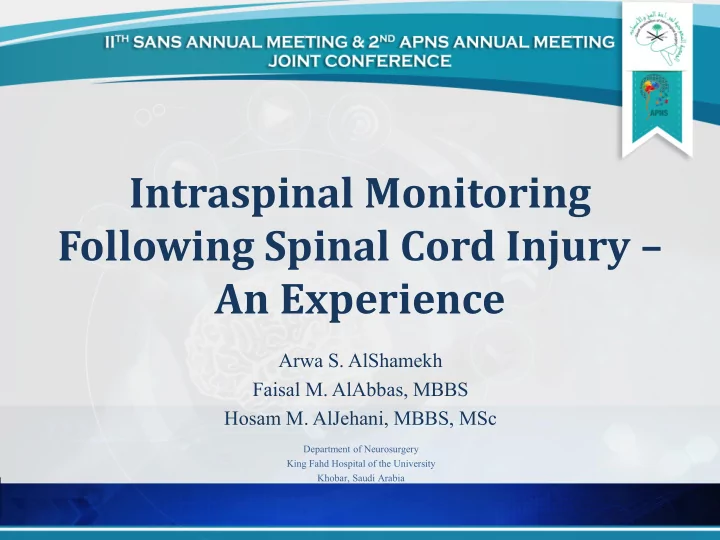

Intraspinal Monitoring Following Spinal Cord Injury – An Experience Arwa S. AlShamekh Faisal M. AlAbbas, MBBS Hosam M. AlJehani, MBBS, MSc Department of Neurosurgery King Fahd Hospital of the University Khobar, Saudi Arabia
Disclosure information • No disclosures
Introduction • Spinal cord injury is debilitating condition that is generally known to be irreversible • Surgical decompression within 24 hours of SCI is the accepted management • Recent literature: detection of changes in spinal physiological parameters, such as intraspinal pressure & spinal cord perfusion pressure • We investigate the changes in physiological parameters using an animal model and correlate them with imaging and histology
Normal Spinal Parameters • ISP= 0-15 mmHg • SCPP= 90-100mmHg • SCPP opt = individualized . ~90 mmHg? • sPRx ≤ 0 intact pressure reactivity • sRAP= -1 ≤ sRAP ≤ + 1 Values closer to 0 + low ISP= good compensatory reserve • Microdialysis: Glucose > 4.5 mM
Literature Review Chen et al. 2017 Khaing et al. 2017 Phang et al. 2016 Calculation of continuous Time-related and structural ISP Evaluation of ISP optimal spinal cord perfusion changes after TSCI in rats. Dural measurement in 42 patients, pressure (cSCPP opt ) and and pial contribution to ISP. with technical nuances, metabolic profile correlation after • ISP 3X within 30 complications, follow-up, and TSCI. minutes, up to 7 days. safety. • cSCPP opt variance + glucose = possibility of better outcome Czosnyka et al. 2016 Varsos et al. 2016 Phang et al. 2015 ISP waveform analysis. 3 peaks: percussion, tidal, and 3 intradural compartments dicrotic. Presence of mean pulse amplitude, mean respiratory with different ISP following amplitude, and mean magnitude of slow waves. Possibility of SCI. Injury site interpretation same as ICP. intraparenchymal ISP = subdural ISP.
Literature Review Electron Imaging microscopy Temporal evolution of Conventional MR: signal axonal autophagy after SCI changes indicating edema, in a rat-model. Max. mean hemorrhage, or interstitial fiber diameter was at 24hrs fibrosis (Ribas et al. 2015) Newer techniques: DTI with lower FA and higher MD, correlated with clinical grade (D ’ souza et al. 2017) MRS in SCI rat model (Zheng et al. 2016)
Objectives • Document normal ISP and SCPP of rats • Document variance of ISP and SCPP when SCI is present • Compare difference of ISP and SCPP between decompressed and nondecompressed groups of SCI • Document time-related radiological findings following SCI • Document time-related histological findings using EM following SCI
Materials and Methods • Animal subjects: 21 female Long Evans rats, into 3 groups: SCI w/ decompression, SCI w/o decompression, and control • Induction: Isoflurane (5% induction, 2.5% maintenance). Continuous MAP recordings for 24 hours using Millar Mikro-Tip catheter • SCI: Area of T7-T8. 14 rats. 3 rd generation spinal cord contusion device 7 rats decompressed by laminectomy and duroplasty within 6 hours of injury
Materials and Methods • Pressure recordings: Codman microsensor ICP catheter. Control group ISP for 3 hours. SCI group at: time of injury, 15 minutes, 30 minutes, 1 hour, 3 hours, 6 hours, 12 hours, 24 hours, and 48 hours after injury • Imaging: Experimental 3.0 T MRI in 4 rats (2 w/ and 2 w/o decompression) at: time of injury, 6 hours, 24 hours, and 7 days after injury • Euthanasia: Administration of CO 2 • Electron microscopy: Imaging under electron microscope. 2 control group rats. 4 SCI rats after 48h, rest of SCI rats after 7 days
Thank you
Recommend
More recommend